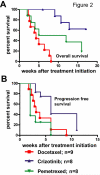Co-clinical trials demonstrate superiority of crizotinib to chemotherapy in ALK-rearranged non-small cell lung cancer and predict strategies to overcome resistance
- PMID: 24327273
- PMCID: PMC3947539
- DOI: 10.1158/1078-0432.CCR-13-1733
Co-clinical trials demonstrate superiority of crizotinib to chemotherapy in ALK-rearranged non-small cell lung cancer and predict strategies to overcome resistance
Abstract
Purpose: To extend the results of a phase III trial in patients with non-small cell lung cancer with adenocarcinomas harboring EML4-ALK fusion.
Experimental design: We conducted a co-clinical trial in a mouse model comparing the ALK inhibitor crizotinib to the standard-of-care cytotoxic agents docetaxel or pemetrexed.
Results: Concordant with the clinical outcome in humans, crizotinib produced a substantially higher response rate compared with chemotherapy, associated with significantly longer progression-free survival. Overall survival was also prolonged in crizotinib- compared with chemotherapy-treated mice. Pemetrexed produced superior overall survival compared with docetaxel, suggesting that this agent may be the preferred chemotherapy in the ALK population. In addition, in the EML4-ALK-driven mouse lung adenocarcinoma model, HSP90 inhibition can overcome both primary and acquired crizotinib resistance. Furthermore, HSP90 inhibition, as well as the second-generation ALK inhibitor TAE684, demonstrated activity in newly developed lung adenocarcinoma models driven by crizotinib-insensitive EML4-ALK L1196M or F1174L.
Conclusions: Our findings suggest that crizotinib is superior to standard chemotherapy in ALK inhibitor-naïve disease and support further clinical investigation of HSP90 inhibitors and second-generation ALK inhibitors in tumors with primary or acquired crizotinib resistance.
©2013 AACR
Figures




References
-
- Christensen JG, Zou HY, Arango ME, Li Q, Lee JH, McDonnell SR, et al. Cytoreductive antitumor activity of PF-2341066, a novel inhibitor of anaplastic lymphoma kinase and c-Met, in experimental models of anaplastic large-cell lymphoma. Mol Cancer Ther. 2007;6:3314–3322. - PubMed
-
- McDermott U, Iafrate AJ, Gray NS, Shioda T, Classon M, Maheswaran S, et al. Genomic alterations of anaplastic lymphoma kinase may sensitize tumors to anaplastic lymphoma kinase inhibitors. Cancer Res. 2008;68:3389–3395. - PubMed
Publication types
MeSH terms
Substances
Grants and funding
- P30 ES010126/ES/NIEHS NIH HHS/United States
- CA166480/CA/NCI NIH HHS/United States
- P01 CA120964/CA/NCI NIH HHS/United States
- R01 CA166480/CA/NCI NIH HHS/United States
- R01 CA140594/CA/NCI NIH HHS/United States
- R01 CA172592/CA/NCI NIH HHS/United States
- P01CA120964/CA/NCI NIH HHS/United States
- R01CA136851/CA/NCI NIH HHS/United States
- R01 CA122794/CA/NCI NIH HHS/United States
- CA163896/CA/NCI NIH HHS/United States
- P01 CA154303/CA/NCI NIH HHS/United States
- R01 CA163896/CA/NCI NIH HHS/United States
- P01CA154303/CA/NCI NIH HHS/United States
- CA122794/CA/NCI NIH HHS/United States
- U01 CA141576/CA/NCI NIH HHS/United States
- R01 CA136851/CA/NCI NIH HHS/United States
LinkOut - more resources
Full Text Sources
Other Literature Sources
Medical

